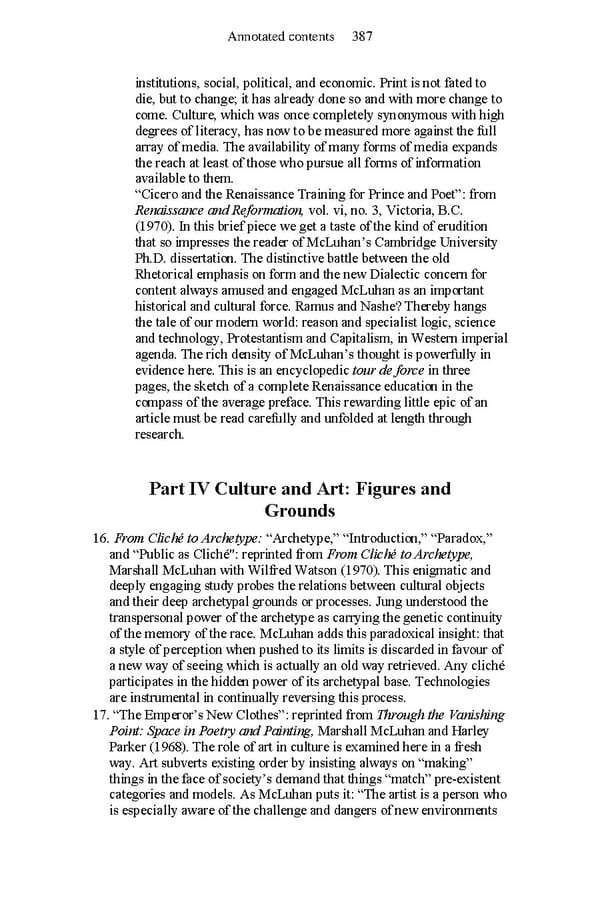Annotated contents 387 institutions, social, political, and economic. Print is not fated to die, but to change; it has already done so and with more change to come. Culture, which was once completely synonymous with high degrees of literacy, has now to be measured more against the full array of media. The availability of many forms of media expands the reach at least of those who pursue all forms of information available to them. “Cicero and the Renaissance Training for Prince and Poet”: from Renaissance and Reformation, vol. vi, no. 3, Victoria, B.C. (1970). In this brief piece we get a taste of the kind of erudition that so impresses the reader of McLuhan’s Cambridge University Ph.D. dissertation. The distinctive battle between the old Rhetorical emphasis on form and the new Dialectic concern for content always amused and engaged McLuhan as an important historical and cultural force. Ramus and Nashe? Thereby hangs the tale of our modern world: reason and specialist logic, science and technology, Protestantism and Capitalism, in Western imperial agenda. The rich density of McLuhan’s thought is powerfully in evidence here. This is an encyclopedic tour de force in three pages, the sketch of a complete Renaissance education in the compass of the average preface. This rewarding little epic of an article must be read carefully and unfolded at length through research. Part IV Culture and Art: Figures and Grounds 16. From Cliché to Archetype: “Archetype,” “Introduction,” “Paradox,” and “Public as Cliché": reprinted from From Cliché to Archetype, Marshall McLuhan with Wilfred Watson (1970). This enigmatic and deeply engaging study probes the relations between cultural objects and their deep archetypal grounds or processes. Jung understood the transpersonal power of the archetype as carrying the genetic continuity of the memory of the race. McLuhan adds this paradoxical insight: that a style of perception when pushed to its limits is discarded in favour of a new way of seeing which is actually an old way retrieved. Any cliché participates in the hidden power of its archetypal base. Technologies are instrumental in continually reversing this process. 17. “The Emperor’s New Clothes”: reprinted from Through the Vanishing Point: Space in Poetry and Painting, Marshall McLuhan and Harley Parker (1968). The role of art in culture is examined here in a fresh way. Art subverts existing order by insisting always on “making” things in the face of society’s demand that things “match” pre-existent categories and models. As McLuhan puts it: “The artist is a person who is especially aware of the challenge and dangers of new environments
 Essential McLuhan Page 393 Page 395
Essential McLuhan Page 393 Page 395